

|
Forum area for discussing hybridizing tomatoes in technical terms and information pertinent to trait/variety specific long-term (1+ years) growout projects.
|
 |
|
|
Thread Tools | Display Modes |
|
|
#1 |
|
Tomatovillian™
Join Date: Sep 2014
Location: France
Posts: 142
|
I've launched a collaborative tomato breeding project this year, so i'll present it in this first message :
Here is the message i posted in the OSSI forum to introduce the project : Here is a fun project i decided to open to other breeders/growers to try to collectively find a dark green colored tomato. Here is the description i've made of it. If anyone is interested let me know. I'm in Europe. Link to the doc which may have a better formatting. Dark Green Tomato Collaborative Breeding Project Project goal Discover tomatoes with dark colored fruits (dark green, dark purple, dark brown), by growing collaboratively a lot of F2 plants . Target color (right fruits) : Origin of the project A spontaneous mutation was discovered in the cultivar Manalpa, leading to an accumulation of chlorophyll before maturation (see above picture). The involved gene is a recessive gene name dg (dark green) or hp-2 (hight pigment). The accumulated chlorophyll is then converted during maturation, giving fruits of a lit bit more intense red color. Goal of the project is to combine the dg gene with other genes that helps to keep the chlorophyll during maturation, thus giving a dark color, and even better to combine it also with genes stopping other pigment colors to appears to keep a dark green colored tomato. In 2011, I crossed the accession LA3005 containing the mutant gene dg with the cultivar Captain Lucky. During 2022, I cultivated some F1 plants. All plant had red colored fruits, which was expected because all involved genes are recessive. 2023 is the exciting year ! Growing F2 generation should allow for the recombination of recessive genes giving the desired phenotype. A bit of Genetic The project is based of three categories of genes :
The dark green color is thus a combination of three recessive genes : dg + gf + ry. Knowing the number and nature of involved genes, one can compute the number of plants that need to be grown in order to have a given percent of chance to succeed. To have a 90% chance of finding a dark green colored fruited tomato, one has to grow ~150 plants of tomato. This statistic is valid even spread among different people. Thus if 6 people grow each 25 plants, there is 90% chance of success that at least one of the grower will discover the dark green tomato. How the project works What you’ll receive Based on your capacity to grow a number of plants protected from late blight, you’ll receive a number of seeds each of F2 generation. Your contribution to the project
What to expect ? The following table list the chances of obtaining a dark green tomato plant (left), or more broadly a dark colored tomato (right). Nb of plants / % chance to find a dark green tomato 25 / 32% 50 / 54% 75 / 69% 100 / 79% 125 / 86% 150 / 90% Once a dark green tomato is found, jackpot ! The recessive character of all three involved gene guarantee that all further generations will be dark colored (excluding spontaneous mutation or accidental cross). Of course not all characteristics of the plant will be fixed in the F3 generation. The plant will need a few more years to be fully stabilized. Meanwhile, those F3 seeds will still be precious to share among other breeders to start a dark green tomato revolution ! What next ? What about crossing these dark green tomato with blue (anthocyanin) tomatoes ? The accumulation of chlorophyll could lead to very dark blue tomatoes. What about adding stripes ? Or developing a ‘real’ dark green tomato crossing the dark green tomato with green tomatoes like green zebra ? |
|
|

|
|
|
#2 |
|
Tomatovillian™
Join Date: Sep 2014
Location: France
Posts: 142
|
For this first year, we got some good interesting stuff ! Here is a recap of lines of interest discovered during this first year of the collaborative project (F2 grow out). Thanks to all members who participated
 First, we've discovered some dark green'ish tomatoes. Those line should combine three recessive genes : dg (dark green, accumulation of chlorophyll), gf (green flesh, retention of chlorophyll during ripening), and r^y (reddish yellow, suppression of some lycopene during ripening). We've got a line from Gabriel F3 Dark Green #3 - Gabriel 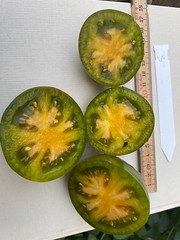 F3 Dark Green #3 - Gabriel  F3 Dark Green #3 - Gabriel 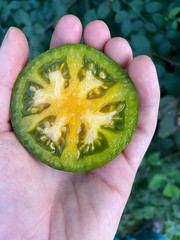 F3 Dark Green #3 - Gabriel  F3 Dark Green #3 - Gabriel  A line from Marie F3 Dark Green (top left) - Marie 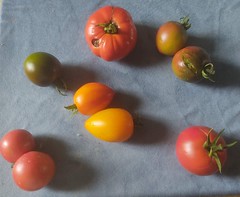 F3 Dark Green - Marie  Maybe a line from Klaus, but i'm not sure if the photos are misleading because fruits have been harvested too early (Klaus can you confirm if it stays relatively green whhen ripe ?) F3 Dark Green (or unripe brown?) - Klaus  F3 Dark Green (or unripe brown?) - Klaus  F3 Dark Green (or unripe brown?) - Klaus 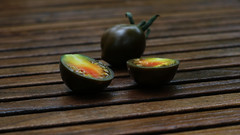 Then we've got brown line, combining the dg and gf genes, but lacking the r^y one. The fruits have intese red parts, dark green interior towards peel, and a brownish external color. A line from Gabriel F3 Dark Brown #8 - Gabriel  F3 Dark Green #3 & Brown8 - Gabriel  At least a line from Klaus F3 Dark Brown - Klaus 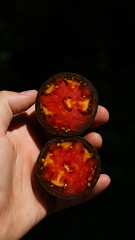 F3 Dark Brown - Klaus  F3 Dark Brown - Klaus  And one from me F3 Dark Brown - Nicolas  F3 Dark Brown - Nicolas 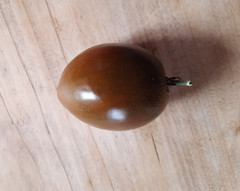 F3 Dark Brown - Nicolas  F3 Dark Brown - Nicolas  F3 Dark Brown - Nicolas  F3 Dark Brown - Nicolas  F3 Dark Brown - Nicolas  Then we've got dark red lines, containing dg but neither gf or r^y Some lines from Gabriel F3 Dark Red #2 - Gabriel  F3 Dark Red #1 - Gabriel  And a line from Klaus, whose fruits are quite bigs and of beefsteak type. Klaus noted that the flesh is firmer, which is apparently a feature of the dg gene. F3 Dark Red Beefsteak (unripe) - Klaus  F3 Dark Red Beefsteak - Klaus  We've aso got lines with lovely red color and dark shoulders. This phenotype is kind of a mystery for me because it dos not contains dg gene (flesh is normal red). So maybe it is caused by the dg gene in heterozygous condition, and/ormaybe some combination with the u gene (uniforma ripening / dark shoulder gene locus). One from Klaus F3 Lovely Red - Klaus  And one from me. F3 Lovely Red - Nicolas  Whats next for the project ? The project has already been successfull because the goal was to combine the dg and gf gene at least, and dg, gf and r^y at best. Some other interesting lines may be of interest like the dark read beefsteak, and lovely red lines. Next step this winter is to get seeds from and for members of this year. Next year i will grow seeds from some lines so seeds could be shared widely outside of the project. Some crosses will be made. I hope that other members will join, and that we will be able to try to get new combination with GWR, striped and/or blue tomatoes. Last edited by nicollas; October 14, 2023 at 01:03 PM. Reason: image resized |
|
|

|
|
|
#3 |
|
Tomatovillian™
Join Date: Feb 2006
Location: Hampton, Virginia
Posts: 1,351
|
Welcome back Nicollas
Very Interesting Protects. From a Biology perspective, this is very Good. It looks like some even turned Red at the end of their Growth. My Green Heirloom Tomatoes do not turn Red when Ripe. Let us know about the Teate next year. Praying for World Peace, Amen!!
__________________
May God Bless you and my Garden, Amen https://www.angelfieldfarms.com MrsJustice as Farmer Joyce Beggs 
|
|
|

|
|
|
#4 |
|
Tomatovillian™
Join Date: Sep 2014
Location: France
Posts: 142
|
My second message does not look great, but there is no code i can edit, and no way to set width when selecting a picture.
Here is a link to the album, will be easier to browse photos : https://www.flickr.com/photos/306477...h/53257365159/ (i finally managed to reduce the width of photos) Last edited by nicollas; October 14, 2023 at 01:02 PM. |
|
|

|
|
|
#5 |
|
Tomatovillian™
Join Date: Feb 2006
Location: Hampton, Virginia
Posts: 1,351
|
Those are Beautiful Pictures. Amen!!
I would love to eat all of those green Tomatoes. The F-3 is similar to my Heirloom Green Tomatoes. They turn more of a yellowish-orange color.
__________________
May God Bless you and my Garden, Amen https://www.angelfieldfarms.com MrsJustice as Farmer Joyce Beggs 
|
|
|

|
|
|
#6 |
|
Tomatovillian™
Join Date: Oct 2012
Location: Vancouver Island
Posts: 5,922
|
Interesting project, good luck with it. I have some hp lines that I think I can identify as seedlings. Do you find big differences in the plants themselves even before fruiting?
KatenO |
|
|

|
|
|
#7 |
|
Tomatovillian™
Join Date: Sep 2014
Location: France
Posts: 142
|
Thanks,
hp seedinlgs are shorter and slower to germinate, they also have an pinkish hypocotyl. But in a paper about seedling identification, the diagnostic was not accurate when gf gene was present, so i was unsure what would i've been able to check for selecting hp2^dg + gf plants. I've made the mistake to oversow so i've selected against dg when transplanting seedlings, oops. I've got only a few dg plants but as mentionned in the literature they are shorter and with darker leaves, dark green immature fruits, and darker red mature fruits. https://cdnsciencepub.com/doi/pdf/10.4141/cjps65-014 |
|
|

|
 |
|
|
